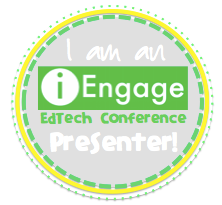Have you perused Jennifer Serravallo's The Writing Strategies Book: Your Everything Guide to Developing Skilled Writers, yet? After getting my hands on The Reading Strategies Book: Your Everything Guide to Developing Skilled Readers back in 2015, I was ecstatic when I heard a writing version of the book was in the works. I waited on pins and needles for it to be delivered, since I preordered months beforehand. Once the book arrived in February 2017, all I could say was Ooh la la!
Oh, Jennifer Serravallo! What can I say besides she is like no other. If you follow my blog, you know I consider her to be one of the most genius literacy consultants and authors out there. I had the pleasurable opportunity of meeting her in person at a conference I attended at the tail end of the 2016-2017 school year, but was able to catch a few of her sessions at the Illinois Reading Conference this past October. She is an accomplished, yet, genuinely kindhearted and down-to-Earth person. She was willing to sign all of the books I currently own that she has authored, as well as take the time to sign books from the hundreds of others who attended.
Before moving on, I'd like to preface that much of this post has been sitting unpublished for many, many months. It has been revised over and over, but to no avail...until now. I was going to participate in a comprehensive book study with some of the wonderful members of the #ReadingStrategiesCrew like we did for our previous book study on The Reading Strategies Book. However, for a handful of reasons, we decided to cancel the study.
Nevertheless, I figured I could share some of the emergent strategies I used with my students and my own kids at the tail end of last school year. Since I'm in a new school this year and in a new role as a Literacy Coach, alongside being a K-2 Reading Specialist, I tested out some strategies that could be used to support kindergarten and first grade students. Praises for Jennifer's work deserve to be sung worldwide!
Since I mostly work with very young students, I tried out a few strategies with my emergent writers from last school year, including my own kids who were in preschool at the time, but have now moved on to kindergarten. I wanted to give you a peek into a few strategies represented in Goal 1.
Goal 1 is Composing with Pictures. There are eighteen strategies within this goal to support pre-emergent and emergent writers. This goal is mostly used to support students in pre-Kindergarten through 2nd grade. However, Serravallo mentions that students throughout the primary grades benefit when they are given time to sketch their ideas before moving into the writing process.
Below is a snapshot of the strategies reinforcing this goal. Just like Serravallo's The Reading Strategies Book, the format is not the typical front cover to back cover type of read, but another handy guidebook to support your instruction. The format allows teachers to pick and choose from researched-based strategies that will best scaffold students. Serravallo states, "I streamlined the language and examples, and I present the strategies in a format that is organized so that the busy teacher can find just the right strategy at just the right moment." Ahhh, music to my ears.
For each strategy, once again, Serravallo includes a description and helpful prompts to use with students. Many of the strategies also provide Teacher Tips and samples of Lesson Language to use when putting the strategy into practice. The strategies can be demonstrated to individuals, small groups or whole class. In addition, along the sidebar of each strategy, Serravallo indicates the level (emergent to grade 8), genre/text type, and process(es) in which to focus. I find these to be invaluable features of the book (just as in The Reading Strategies Book) because even a novice or experienced classroom teacher without a writing background can fully support and guide his/her students in writing. This book elicits powerful writing instruction!
In view of the fact I work with struggling readers at school, which often correlates to weak writing abilities, as well as have little ones at home in the early stages of writing, Goal 1 suited me perfectly. An example of Reread Your Pictures to Teach (1.4), Label Your Pictures (1.6) and A Series of Pictures to Show Change (1.13) are discussed in this post. All eighteen strategies within this goal are worthwhile, of course.
If you teach young students or have little ones at home who are budding writers, you're aware of how tricky writing letters and words can be for some. Serravallo explains that writing instruction can begin well before students are even able to connect letters into words and words into a piece of writing. She added the work of researchers Ray and Glover stating, "By teaching children to compose with pictures, they can be freed up to create texts in any genre and to understand that meaning comes first, long before they are ready to spend lots of mental energy hearing the sounds in words and writing down what they hear (p.34)."
Reread Your Pictures to Teach
The Reread Your Pictures to Teach strategy focuses on students orally explaining facts about a chosen topic. Here are the *Who's this for?* stats: Level: emergent, Genre/Text Type: informational/nonfiction, Process: reading writing aloud. This strategy encourages students to retell their *writing* in picture form. Be mindful when thinking about writing children's words for them on their pictures. The Teaching Tip for this strategy comes with a forewarning:
"Some teachers record students' speech right on their writing/pictures, but many believe this negatively impacts a student's agency and confidence for writing words when she is ready. When an adult writes on a child's paper, this may communicate that the child's attempts at making meaning don't make sense without the teacher's written words, which may undermine her future attempts at writing pictures and/or with words (Ray and Glover 2008)."
 |
| Image from The Writing Strategies Book |
After reading about this strategy, my own preschool kiddos popped into mind. At the start of Spring in 2017, they began learning at school all about the the life cycle of a chicken. We took a family trip to the library, checked out a few books, built a little background and then began extending our learning about chickens. Below are some pictures taken in their preschool classroom and at home.
Once my kids learned a bit more about the life cycle of the chicken, my daughter began drawing what she learned and then reread her pictures to teach her father all about it.
To get a better sense of the Reread Your Pictures to Teach strategy for informational/nonfiction writing, here are a few ideal prompts found in the book:
- What does this picture teach about?
- Point to a part and tell me what I can learn from that.
- Do you know other facts?
- What does this part of the picture teach?
- Sound like a teacher.
- Your drawing teaches a lot of facts about the topic!
Label Your Pictures
The Label Your Pictures strategy is self-explanatory. Students draw a picture, then use sounds they know to label their images. Here are the *Who's this for * stats: Levels: emergent-K, Genre/Text Type: any, Process: drafting. The Teaching Tip suggests students be assessed on letter-sound identification prior to use of this strategy. If students have a strong foundation of letter-sound correspondence, they are typically ready for for labeling. However, the Teaching Tip also forewarns:
"Pushing the conventional writing/print too soon could overly focus the child on getting down words rather than other qualities of good writing such as structure and elaboration (p.43)."
 |
| Image from The Writing Strategies Book |
My son, on the other hand, began drawing what he learned and then labeled his pictures to teach his father and me all about his newly found knowledge. His pictures are below.
The Label Your Pictures strategy can be used with any genre. Serravallo suggests using prompts such as these:
- What sounds do you hear?
- Say the word slowly.
- What letters make that sound?
- Write the letter down, and say the word again?
A Series of Pictures to Show Change
A Series of Pictures to Show Change strategy focuses on students being able to depict how real life things can move or gradually change over time. Here are the *Who's this for?* stats: Levels: emergent-2, Genre/TextType: narrative, informational/nonfiction, procedural, Process: drafting.
 |
| Image from The Writing Strategies Book |
For this strategy, I enrolled some of my willing and eager first grade boys last year who were really into learning about frogs. The book How Frogs Grow found in the F&P LLI kit is what piqued their interest, so I found some other related titles I had on hand. Below are some snapshots of their work, as well as a video of one who wanted to share his learning.
The prompts for A Series of Pictures to Show Change strategy can be used with narrative and informational or procedural genres, so below are some recommended prompts that compliment this strategy:
- Who's that? What's happening?
- What did she do next?
- Can you draw that next part in a new picture?
- What's the next thing she does?
- Draw a picture to show what it looks like when it starts.
- Draw a picture to show how it changes.
- Draw a picture to show how it changes again.
Happy Tuesday, folks!
















































0 comments:
Post a Comment
I would love to hear from you, so please leave a comment. Come back for a visit sometime soon, too! :)